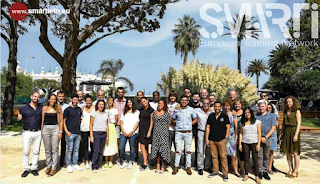What's RaCoMo about?
Hi guys! It's been a while since my first post. I’m sorry for not writing sooner but I was quite busy with work, first year report and then I finally was able to manage to go home on holidays for a while. But, here we go: I’m back!
Today I would like to introduce a bit more of my project. RaCoMo means "development of a RAilway system component (earthworks, transitions, trackbed, drainage) remote COndition MOnitoring methodology and analysis tools to predict future system deterioration".
The railway infrastructure industry addresses continuous works for improving its safety, profitability and sustainability. In this direction, a well-established asset
management of risks and interventions is required for guaranteeing system good performance. Development of Geotechnical Asset Management (GAM) is part of a national effort to implement Transportation Asset Management (TAM) and Performance Management (PM). GAM targets to reduce uncertainty enabling expertise to make well-informed decisions and optimised utilise resources. Geotechnical assets such as embankments are complex and our understanding of their services lives is incomplete. Means to estimate the condition of these assets and monitor their condition over time are required for a fully functioning asset management program.
The risk of embankment failures is frequently higher than on other infrastructures, especially in the UK where most of the embankments were built during the 19th century not following the modern rock mechanics science, and often failure is swift and catastrophic. RaCoMo project aims to reach a deep
understanding of factors influencing the performance of a railway system and leading to embankment failures. Owing to their complex construction history, together with a lack of understanding of their mechanical behavior, UK railway embankments have inherited several factors which make them vulnerable to damage from the traffic loading. Such damages would manifest themselves through increased maintenance and poor trackbed performance. The risk of derailment from slope failures is the greatest risk faced by the railway infrastructure. Efficient and effective management of geotechnical infrastructure assets is essential to meet performance requirements.
 Some existing models are able to couple features of the asset. Although these works are remarkable they do not provide sufficient accuracy to determine a manageable number of assets to monitor in more detail. As result, much effort is focused on the day-to-day management of embankments and reactive
Some existing models are able to couple features of the asset. Although these works are remarkable they do not provide sufficient accuracy to determine a manageable number of assets to monitor in more detail. As result, much effort is focused on the day-to-day management of embankments and reactiveMy research takes place in this scenario. During the first year I tried to understand how the performance of a railway track system results from a complex interaction of the system components in response to train loading and it is critically dependent on parameters affecting the stability of assets. So the aim of the research is determining and weighting which parameters play a significant role in leading to embankment deterioration. I highlighted these parameters from the literature and I divided them into three macro categories: soil mechanics properties, geotechnical issues and external factors.
To try covering the gaps, I am working on the development of a new
 model for embankments deterioration to predict areas where failure is most likely to occur; it may be possible with the model to reduce the risk of unforeseen failure, and improves monitoring of those assets where greatest risk of failure exists. A statistical approach, precisely a Multi-Criteria Decision Making method, will be used to manage the complexity of the asset, the variety of failure mechanisms and all the parameters (geotechnical and external) playing a role in the possible displacement.
model for embankments deterioration to predict areas where failure is most likely to occur; it may be possible with the model to reduce the risk of unforeseen failure, and improves monitoring of those assets where greatest risk of failure exists. A statistical approach, precisely a Multi-Criteria Decision Making method, will be used to manage the complexity of the asset, the variety of failure mechanisms and all the parameters (geotechnical and external) playing a role in the possible displacement.
The outcome will be a tool able to link embankment conditions to right immediate action needed and so support the decision maker in their unique and personal decision process. This will help industries in improving their geotechnical asset management strategy for a more profitable, more reliable and safer railway system.
What I like the most of this research is the possibility to deliver something useful for the industry. My host institution is AECOM indeed, an American multinational engineering firm that provides design, consulting, construction, and management services in multiple fields. Working with this
company, and in particular with the Railway Intelligence Infrastructure team in Nottingham office, gives me the chance to focused the attention on the real needs of an industry and so trying to produce a beneficial result for the daily management! As all this work will lead me (hopefully!) to reach the PhD, I am also lucky enough to receive help in my work from my supervisors in Nottingham Transportation Engineering Centre NTEC at The University of Nottingham.
Hope this brief description gave you a whole idea of what I am working on and how I am trying to contribute to the scientific community!
See you soon guys! ☺
Cheers
See you soon guys! ☺
Cheers






Comments
Post a Comment